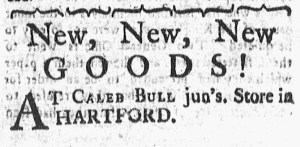What was advertised in a colonial American newspaper 250 years ago today?

“New, New, New GOODS!”
Less is more. Caleb Bull, Jr., adopted that theory for his advertisement in the May 19, 1772, edition of the Connecticut Courant. Extending only four lines, the advertisement proclaimed, “New, New, New GOODS! AT CALEB BULL jun’s. Store in HARTFORD.” He did not include any of the standard appeals to price or quality. He did not attempt to convince genteel customers that he carried fashionable textiles, garments, and housewares. He did not provide a list of dozens or scores of items to demonstrate the choices available to consumers. He did not promise exemplary customer service. In short, he did not deploy most of the marketing strategies that commonly appeared in newspaper advertisements in the eighteenth century.
That does not necessarily mean, however, that Bull’s advertisements did not catch the attention of prospective customers. After all, he composed innovative copy with the repetition of “New, New, New” on the first line. Most advertisers did not incorporate such repetition as a means of engaging readers, though sometimes their lists of merchandise concluded with “&c. &c. &c.” In repeating the abbreviation for et cetera, they underscored that they had far too many goods to fit into an advertisement. Bull relied on a similar principle, but he did not reserve the repetition for the end of his notice. Instead, “New, New, New” served as his primary marketing strategy, signaling to prospective customers that his inventory had not lingered on the shelves. Bull challenged readers to visit his store to see these “New, New, New GOODS” for themselves.
The typography made his advertisement notable, most of the content in larger fonts than appeared in other advertisements on the same page. Other notices featured dense paragraphs in smaller fonts. Readers likely absorbed Bull’s advertisement at a glance, even if they casually skimmed the advertisements, but other notices required greater effort to read. As a result, “New New, New GOODS” may have been enough to make Bull’s advertisement memorable and effective,


